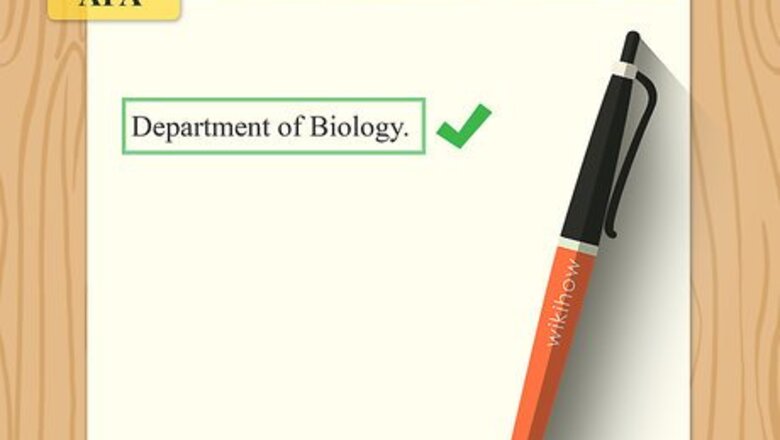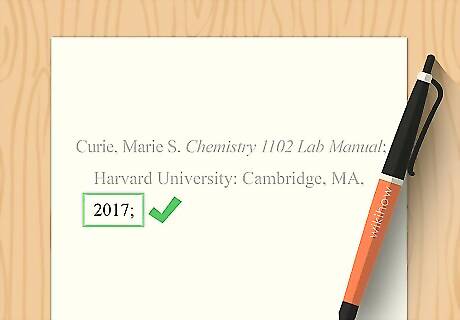
views
X
Research source
APA

Start with the department name as the author. An APA citation normally starts with the name of the author of the reference being cited. However, if you're citing to a lab manual, you'll use the name of the university department for which the lab manual was created instead. Follow the department name with a period. For example: "Department of Biology."

Identify the year and semester in parentheses. Immediately after the name of the department (in place of the author's name), write the year the lab manual was used, followed by a comma. After the comma, right the name of the semester the lab manual was used (typically "Fall" or "Spring"). The name of the semester should be capitalized. Place a period after the closed parentheses. For example: "Department of Biology. (2018, Spring)."

List the title of the lab manual in parentheses. Immediately after the date information, put the title of the lab manual using sentence case. Only capitalize the first word and any proper nouns in the title. If the course name is included, use the same capitalization as used in the course catalogue. Place a period after the title of the lab manual. For example: "Department of Biology. (2018, Spring). BIOL 101 lab manual."

Provide the location and name of the university. For the next part of your citation, include the city and state or province where the university is located, then a colon followed by the name of the university. Do not use abbreviations for either the location or the name of the university. Place a period after the name of the university. For example: "Department of Biology. (2018, Spring). BIOL 101 lab manual. Chapel Hill, North Carolina: University of North Carolina at Chapel Hill."

Add a URL for online lab manuals. If the lab manual is available online, such as from a website for the course, end your citation with the URL where the lab manual can be found. Type "Retrieved from" followed by the title of the site (or a description, if the site isn't titled), then copy the full URL. End your citation with a period. For example: "Department of Biology. (2018, Spring). BIOL 101 lab manual. Chapel Hill, North Carolina: University of North Carolina at Chapel Hill. Retrieved from class website at http://unc.edu/courses/bio/101/lab_manual.pdf."

Use the author-date system for in-text citations. In addition to your bibliography, you also must provide in-text citations at the end of any sentence that directly references or quotes from the lab manual. Place the name of the department and the year the manual was used in parentheses. For example: "(Department of Biology, 2018)."
ACS

Start with the name of the instructor. Generally, in ACS style you treat a lab manual as a book that was authored by the instructor of the class in which the lab manual was used. Use the professor's last name, followed by their middle initial. Place a period after the initial. For example: "Curie, Marie S."

Provide the title of the lab manual in italics. Write the title of the lab manual in title-case, capitalizing all words except conjunctions, articles, and prepositions. Place a semi-colon after the title. The semi-colon should not be italicized. For example: "Curie, Marie S. Chemistry 1102 Lab Manual;"

List the university as the publisher. Since the instructor is employed by the university where they teach, the university is placed in the position where you would normally list the publisher. Use the full name of the university without abbreviations. Place a colon after the name of the university. For example: "Curie, Marie S. Chemistry 1102 Lab Manual; Harvard University:"

Include the location of the university. Following the colon, provide the city and state or province where the university is located. Use standard abbreviations for the state or province, then place a comma. For example: "Curie, Marie S. Chemistry 1102 Lab Manual; Harvard University: Cambridge, MA,"

Note the year the lab manual was published. Consider the year the lab manual was used to be the year it was published. You'll typically find the year on the cover or first page of the lab manual. End your citation with a period, unless you're including a page number. For example: "Curie, Marie S. Chemistry 1102 Lab Manual; Harvard University: Cambridge, MA, 2017."

Add the page number if necessary. Depending on the style of in-text citations you're using, you may be using end notes rather than a separate bibliography of references. If your citations are end notes, you may need to pinpoint the specific page referenced. Use a semi-colon instead of a period after the year of publication, then type "p" with no period, a space, and the page number. For example: "Curie, Marie S. Chemistry 1102 Lab Manual; Harvard University: Cambridge, MA, 2017; p 21."

Use the appropriate method for in-text citations. Under ACS style, there are 3 possible ways to cite your references in text. The appropriate method depends on what your instructor or supervisor expects. Superscript numbers appear outside any punctuation and refer directly to the end note. If using superscript numbers, your end notes would include specific page numbers where necessary. Another method is italicized numbers in parentheses. These are placed inside any punctuation. These also refer to end notes, which would include specific page numbers where necessary. Your instructor or supervisor may also prefer author-date parenthetical in-text citations. When using this method, your citation would not necessarily include specific page numbers. Instead, you'd note the page number within the parenthetical citation if necessary.
CSE

Choose the correct style variation. There are 3 acceptable style variations in CSE: the name-year or Harvard style, the citation-sequence or Vancouver style, and the citation-name style. If you're using CSE, check with your instructor or supervisor to find out what style they prefer. The Harvard style uses author-date parenthetical citations in-text, and has an alphabetical reference list. This is the method preferred by the CSE, so use it if you have no other guidance. The Vancouver and citation-name styles use superscript numbers to refer to a numbered reference list. The citations in your reference list are ordered by their first mention in your paper or report.

Start with the author's name. For a lab manual, the author typically is the professor or instructor of the class in which the manual is used. Start with their last name, then a comma and their first and middle initials. Capitalize initials with no periods or spaces. Place a period after the author's name. For example: "Nye, WS."

Follow the author's name with the year in Harvard style. If you're using the Harvard style, the author's name is followed by the year of publication. This is typically the year in which the lab manual was used. Place a period after the year. For example: "Nye, WS. 2016."

Provide a title and description. The title of the lab manual follows either the author's name (Vancouver) or the year of publication (Harvard). Use sentence-case, capitalizing only the first word and any proper nouns in the title. Capitalize course names or abbreviations as they appear. Put the words "lab manual" in brackets after the title for a description. Place a period after the brackets. Harvard example: "Nye, WS. 2016. Chemistry 213L lab manual [lab manual]." Vancouver example: "Nye, WS. Chemistry 213L lab manual [lab manual]."

Note the location and name of the publisher. For a lab manual, the university where the instructor or professor teaches is typically considered the publisher. Provide the city where the university is located, followed by the state or province in parentheses. Place a colon after the location information, then provide the name of the university. Close with a period for Harvard style. Use a semi-colon after the university's name in Vancouver or citation-name style. Harvard example: "Nye, WS. 2016. Chemistry 213L lab manual [lab manual]. Buffalo (NY): University at Buffalo." Vancouver example: "Nye, WS. Chemistry 213L lab manual [lab manual]. Buffalo (NY): University at Buffalo;"

Put the year at the end for Vancouver and citation-name styles. If you're using either the Vancouver or citation-name style, you still need to include the year the lab manual was published. These styles put it at the end of the citation, rather than immediately after the author's name as in the Harvard style. For example: "Nye, WS. Chemistry 213L lab manual [lab manual]. Buffalo (NY): University at Buffalo; 2016.




















Comments
0 comment